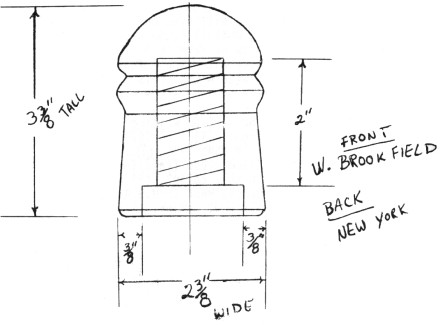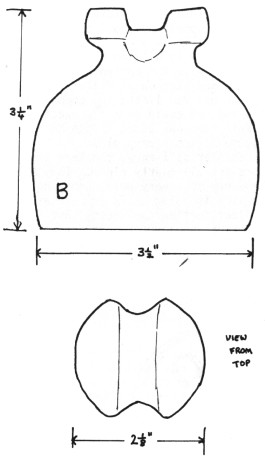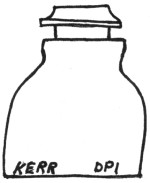Questions Answered by N. R. Woodward
Author of The Glass Insulator in America and originator of C.D. #'s (Consolidated Design Numbers)
Reprinted from "INSULATORS - Crown Jewels of the Wire", July 1977, page 4
Ken Crawford, Saddle Brook, New Jersey, writes: We have two Corning Pyrex
insulators (that I had to climb 20 feet for) that are damaged. the "PYREX
T.M. REG. U.S. PAT. OFF./MADE U.S.A. 63" has 3/4 of the skirt broken off!
Is it worth anything because of the carnival finish? We also have the
"CORNING PYREX T.M. REG. U.S. PAT./OFF. MADE IN U.S.A. 662" which
isn't as badly damaged as the "PYREX 63". It has three 3/4" skirt
chips and, believe it or not, two 3/4" holes bored into it! The rest of
these two insulators are intact. What is the value of our damaged "PYREX
662"? I still consider them valuable because they're carnival glass made by
Corning. Please tell us what you think they're worth and tell us all about Corning Pyrex insulators, since we do not know how old they are, or their
current value, or anything.
We think they are fabulous and wish we had more of
them. Does Corning still make new carnivals? We already have written to Corning
Glass Works and are still waiting for an answer. Should we keep broken Pyrex
carnivals? We also have the "HEMINGRAY-62/MADE IN U.S.A." (applied
amber finish) with a rear ear chip about an inch long. Is this an older
Hemingray series, or a recent model? How about the aqua "HEMINGRAY-16/MADE
IN U.S.A." toll (sharp drips, no inner skirt)? Is this older than the Hemi-20's, 40's, 42's, etc? It seems that the lower the Hemingray series number, the
older. Is this true? In our area, we never see any tolls, exchanges, or ponies
(glass). Are they older and rarer than the insulators used today? How about the
transpositions? Do they still use them today, and, if so, where?
- - - - - - - - -
In reply to Ken Crawford: Corning Glass Works made pin insulators from
approximately 1924 to 1941. The earliest iridized ("carnival") items
were offered as "marker" insulators. That is, they were sprayed with
a non-conductive solution of metallic salts for visual effect. These were sold
mainly to the railroads for use on the power supply wires that fed the block
signal systems and carried a sometimes dangerous voltage. This identified them
from the communication and other low-voltage signal circuits on the same pole.
Your brightly colored No. 63 and 662 are of this type. Since a relatively large
number of these were sold, they do not have a high value and probably would be
considered as valueless in their damaged condition. However, they are still
beautiful and make meaningful additions to your personal collection since you
found them. The exact dates for these are not known, but would be very late
1920's or early 30's.
Later, it was learned that the iridizing gave the insulators a different and in some ways superior electrical property. Therefore, both
Corning and Owens-Illinois (Hemingray) iridized limited numbers of various
designs of communication and power insulators solely for the electrical, rather
than visual, effect. As a result, many of the later ones, especially Hemingray,
aren't so vividly colored and aren't very pretty. Most of this occurred during
the 1930's and probably reached its peak about 1934.
In reply to your questions about Hemingray insulator styles: no, the style
numbers do not increase in the order they were introduced. Since various types
of lines have various requirements in insulators, at any one time many styles
were being made. Of course, there is a definite evolution as old styles were
dropped and new ones introduced. But the entire picture is very complex, and a
question such as yours can't be answered in limited Crown Jewels space.
It is interesting to note, though, that some of the smaller Hemingray numbers in
the 9 to 16 range correspond to their approximate weight in ounces. It is
possible this is where they had their origins. Basically, though, they are just
style numbers for the purpose of identifying suitable insulators when ordering.
The HEMINGRAY - 16 / MADE IN U.S.A. with sharp drips would be 1919-1920
production.
The "applied amber" Hemingray - 62 I've seen carry a 1942 date.
Transposition insulators are still in service where there are open wire lines
on local circuits. But such lines are disappearing or have disappeared from most
of the country. Most of the transpositions one will find on the lines today are
CD #197 (Hemingray - 53, Whitall Tatum - 15), and CD #230 (Hemingray - 56,
Armstrong- TW or Kerr TW.). The remaining open wire toll lines transpose with a
Case four-point bracket and No. 1088 insulators; or with 4 CSC or TS pin
insulators.
From Milo E. Holland, Sr.: I am writing about a couple items that I
recently acquired. (1) A CD 107 (F) ARC-WHITALL TATUM / No 9 // (B)
ARC-MADE IN USA / 7-47 /  . The color appears to be a very light yellow-green (vaseline color). Has anyone
else seen this one in this color? (2) A CD 115 (F) WHITALL TATUM CO. No 3
/ 27 // (B) MADE IN U.S.A.
. The color appears to be a very light yellow-green (vaseline color). Has anyone
else seen this one in this color? (2) A CD 115 (F) WHITALL TATUM CO. No 3
/ 27 // (B) MADE IN U.S.A.  This one appears to be very light (flashed?) amber. I had taken this one off a
line in western Mass. about 8 years ago, and it got packed away. I finally dug
it back out of my cellar. Any information would be appreciated.
This one appears to be very light (flashed?) amber. I had taken this one off a
line in western Mass. about 8 years ago, and it got packed away. I finally dug
it back out of my cellar. Any information would be appreciated.
- - - - - - - - -
In reply to Milo E. Holland, Sr.: The CD #107 (1947 production) that you
describe would be normally almost colorless. I have no way of knowing if the
color of your specimen has been altered. It's possible.
The CD #115 you describe would be very early 1930's production, and the very
light amber would be entirely correct for it.
Chuck Moylan, Kansas City, Missouri, asks: Is there any proof that
Hemingray produced insulators for C.E.W. and, prior to 1871, for E.C.M. Co.?
Also, I would like to know if any threaded insulator has ever been found in
cobalt blue which can be linked to some manufacturer other than Hemingray
(excluding C.E.W. and E.C.M. Co.).
- - - - - - - - -
In reply to Chuck Moylan: Insofar as I know, there is no way to establish a
connection between Hemingray and any of the early West Coast insulators. For one
thing, the physical characteristics of the insulators indicate manufacture by
different methods and on very different type presses.
There are other blue insulators outside the Hemingray line, Westinghouse for
one. However, since Hemingray does seem to have the majority of the vivid blue
colors, it is quite probable they have colors that couldn't be found in another
line. Just where to draw the line between "cobalt" and other similar
blues becomes a bit subject to question, though. So a direct answer is tough.
Noel D. Hatfield, Stromsburg, Nebraska, writes: I have a number of
different shaped 102 Brookfields. But this one is so heavy and squat looking I
want to ask you if it's just another 102 or what? It is light blue with some
ghost letters.

- - - - - - - - -
In reply to Noel D. Hatfield: Yes, CD #102, 1890's production. These are very
attractive. Most have a letter on the crown. Does yours?

From Stanley T. Saeger, Jr.: I have a green glass saddle groove
insulator (see drawing). This one and approximately four like it were found on
an abandoned building in my home town, Bethlehem, Pennsylvania.
I would appreciate any information as to its value. I have not seen it in
anyone's book.
The only embossing it carries is a small "B" about 1/4" high.
I assume it was made by Brookfield. It is broken below the saddle groove. It is
a clean break and should not take off too much value after it is repaired.
I would like information, also, as to its date of manufacture and
manufacturer (Brookfield?).
- - - - - - - - - -
In reply to Stanley T. Saeger, Jr.: Your saddle groove "B"
insulator is most interesting! It would be a Brookfield design from the early
years of electric power transmission lines. That style of crown with very small
groove, gave way to more practical design in the early 1900's. Since it had the
small groove, it would have been for early AC lines, 1890's. This is probably
the most interesting find in its class in some years! Incidentally, it appears
to be virtually identical to Jack Tod's U-558 porcelain. Perhaps they were
supplied for the same system!

From William Mueller, Buffalo, New York: I have an insulator I found
at a flea market, not listed in Milholland's 1976 book. (See drawing on
following page.) It is exactly like a CD 155, but has a flat top. It is in clear
glass, embossed (F) KERR - DPl (B) MADE IN U.S.A. - nos. and
dots. I am wondering if anyone has one in any other color. So far no one I have
talked to has seen one like it. Where are these Kerr insulators hiding? Hope I
can find something about this one.
- - - - - - - - - - -
In reply to William Mueller: The Kerr DP1 is the current CD #155, produced
and stocked at Millville, New Jersey. Had you listed the complete embossing, we
could know its exact age. The Kerr name was added to the No. 1 in 1973, so it
isn't very old.
Insofar as I know, the Kerr insulators are all nearly clear. They have a
tendency to a very pale, smoky aqua tint. Since so little open wire is being
built or maintained in the country now, it is harder to find the Kerrs. But if
you see new cases of insulators being opened and placed on the line, chances are
they're Kerr. It's ten years since the last Hemingray insulators were made, and
most stock is gone.
| 